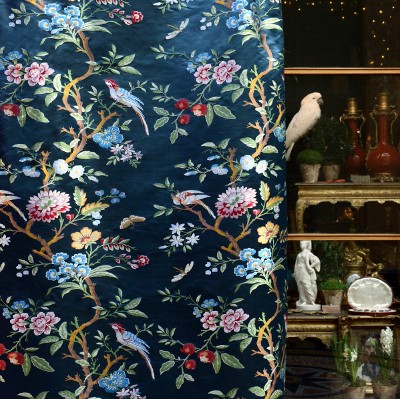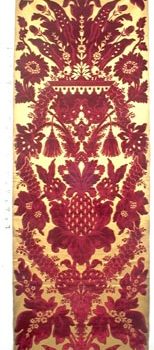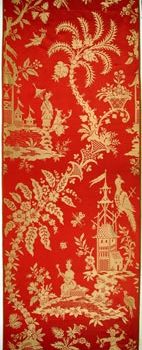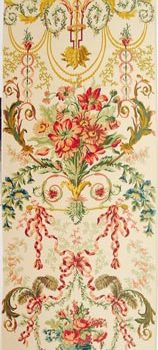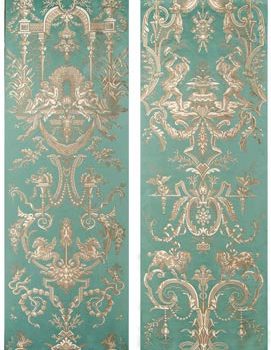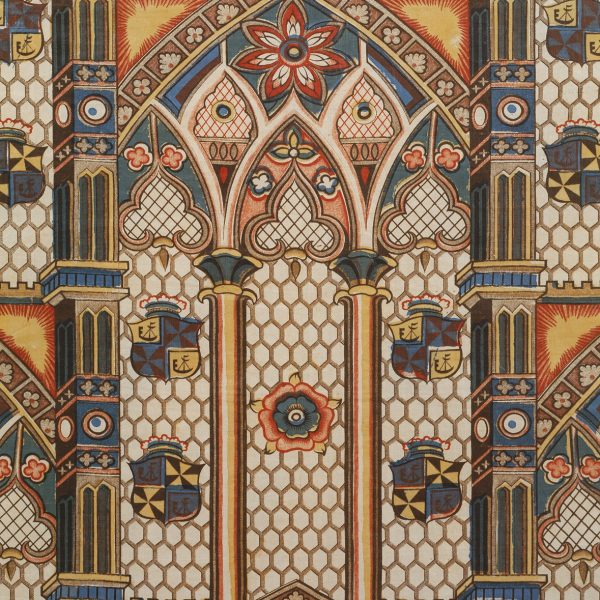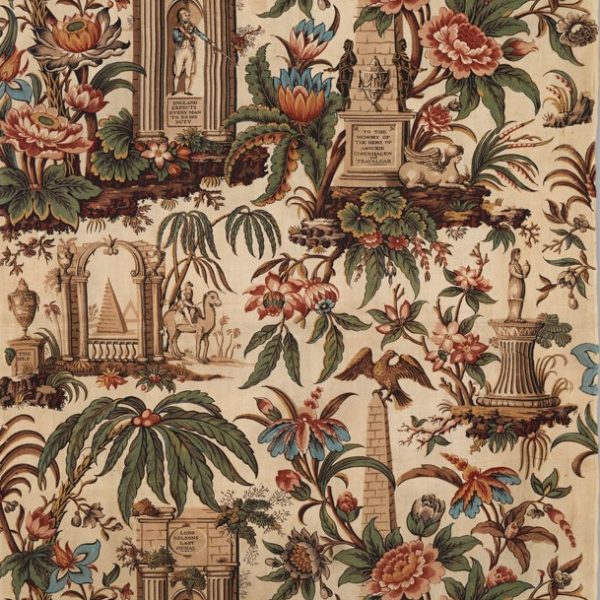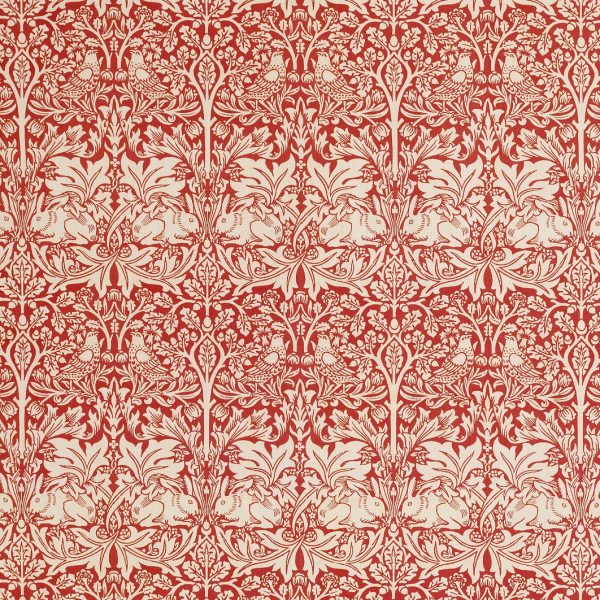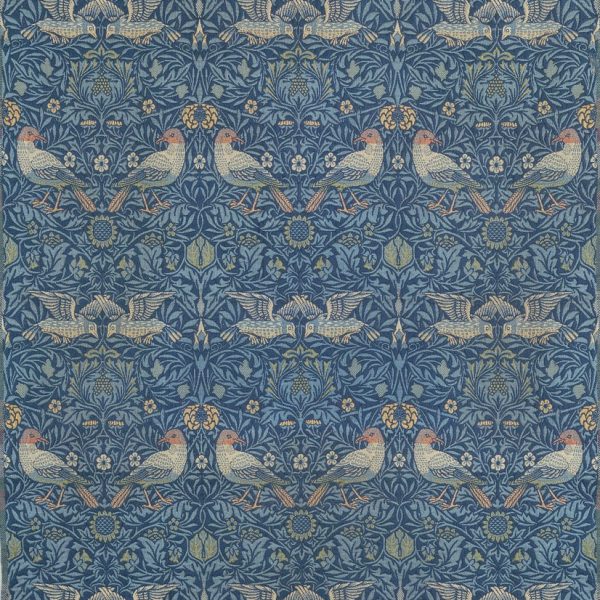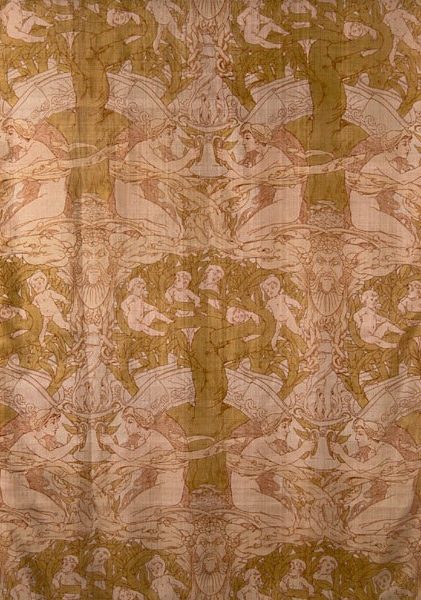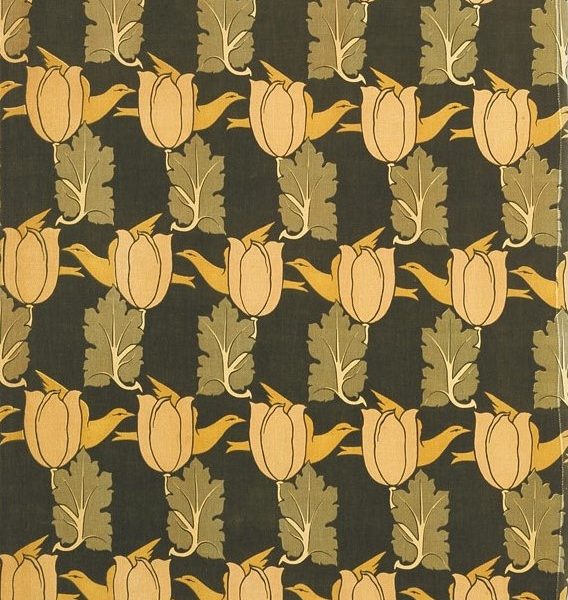Tassinari & Chatel
“As silk weavers of Lyon with an enviable reputation for more than three centuries, Tassinari & Chatel combines technological innovation with traditional savoir-faire to create its exceptional silks. The family firm of Tassinari & Chatel is the culmination of a long dynastic line : four generations of Pernon, two generations of the Grand family, four generations of both families of Tassinari and of Chatel and now two generations of Lelievre.”
Velours Salle Du Trone This fabric was originally woven for Carlos III between 1759 and 1788. It was then Genoese cut velvet, in crimson on a gold satin background with a motif of pineapple fruits and leaves. It was originally produced for the Throne Room of the Royal Palace in Madrid, as wall covering, curtains and lambrequins.
Lampas Regence: This Regency lampas is composed of two motifs of flowers and acanthus leaves framed by a flowing treillis. Typically lampas is silk and due to the complicating production method is considered a luxury fabric.
Billard de Marie-Antoinette: A brocade with a satin background, and velvet clouded silk effect. Designed in 1779 by Gondoin for the winter furnishings of the inner cabinet of Marie-Antoinette at Versailles and rewoven for the billiard room of Les Petits Appartements of Marie-Antoinette at Versailles. The design made up of flowers and garlands in silks and chenille consist of 34 colours, contains empty spaces in which a separately woven medallion can be inserted by embroidery.
Lampas a la Pagode: A Lampas with Chinese motifs in the Louis XV style.
The design contains sinuous palm trees with varied foliage…Amongst the curves there are birds, a musician, a Chinese lady holding a parasol and above all the motif of a pagoda. The design was rewoven for a reconstruction of the Chinese salon at the Chateau de Champs sur Marne and for the great chamber of the Hotel St Florentin in Paris…”
Imprime Saint Cloud: Originally, this design was executed as a Brocarde white Gros de Tours background and patterns of bouquets of tulips, roses, asters, ribbons and pearls. From a design, by Desfarges in 1786, this fabric was supplied in 1788 for the bedchamber of Louis 16th at the palace of Saint-Cloud. This furnishing was not sold during the French Revolution and was later used for the bedchamber of Napoleon in the palace of Tuileries in Paris, up until 1808. The same design has been used as a print on Gros de Tours, but could be rewoven in its original quality.
Brocatelle Karbowsky A typical design of the 20th century composed of a rosette of laurel leaves and a vase with flowers. The pattern was imagined by the designer Karbowsky in 1912, and woven by Tassinari & Chatel. It has since been rewoven several times for Art Deco reconstitutions.
Lampas des Forgerons: This Design by Reboul and Fontebrune was woven for the Salon des Jeux du Roi at Rambouillet. This design contains amongst its many details, sea horses, hounds and blacksmiths at work and at rest. The fabric was woven several times between 1785 and 1791, and was used in 1787 for the Bedchamber of Thierry de Ville d’Avray in the garde meuble royal, which later became the Ministere de la Marine in Paris. This exceptional suite of furniture in gilt wood by Séné was acquired after the French Revolution by James Swan and is now if the Fine Arts Museum in Boston. In 2001, Tassinari & Chatel reworked the design for the restoration of this room in Boston. The furniture was reupholstered in France by Remy Brazet, which revealed that Thierry de Ville d’Avray had placed human figures on some of the seats, which was against the usual custom of the period.
Lampas les Fougeres: Woven in 1785-1786 by Pernon, the brocaded Gros de Tours with a green cannelé background, with a design of garlands of flowers, bouquets of fern and strings of pearls, was ordered for the bedchamber of Louis 16th at Compiegne.
Made up in 1786 for the Bedchamber, it consisted of wall hangings in 4 pieces, the bed à la Duchesse, portieres and upholstered furniture; it was reused for the Directors of the Luxembourg Palace in Paris. Under the Empire, this Pernon fabric was reused in the Salon Circulaire of the Rendez-vous de Chasse of the Etang de la Tour at Rambouillet castle.
In 1978, French President Giscard d’Estaing ordered this fabric, which was only hung in the Elysée recently in the Salon des Tableaux on request of President Chirac and inaugurated for the visit of Pope John-Paul II in Paris in 1997.
Broche Paysage Chinois: A magnificent brocade of silk and chenille with Chinoiserie decoration in the Louis XV style, with a matching border. The various motifs are rich in details with scenes of people at work, houses next to a lake with a boat and very beautiful flowers with birds of paradise.
Lampas les Quatre Parties du Monde: This Lampas, in blue and silver, was woven in Lyon in 1784 for the Grand Cabinet of Marie-Antoinette at Rambouillet. It has been rewoven on several occasions since 1970 for the presidential residences. This Lampas woven in 54cm width, in the Louis 16th style, represents the four continents, with Asia, the Americas, Europe and Africa.
Text and images Tassinari & Chatel:
Joseph-Marie Jacquard (1752–1834) invented the Jacquard mechanism, a patterning device than, when attached to a loom, made it practical to weave more detailed designs than were previously possible. This woven silk portrait of the inventor is based on a painting by Claude Bonnefond (1796–1860) that was commissioned by the city of Lyon in 1831. The Lyon manufacturer Didier, Petit et Cie ordered the silk version from weaver Michel-Marie Carquillat, who became a specialist in this kind of work. The Museum owns another woven picture after a painting by Bonnefond, showing the duc d’Aumale (son of the French king Louis-Philippe) visiting Carquillat’s atelier.
Panel of lace: This lace border incorporates images of modern transport and transmission of power with railway trains, hot-air balloons, telegraph poles, and electric lights. The motifs echo a preoccupation with the new electrical power, much in evidence at the Paris Exposition, and the lace won a medal. The machine-made lace industry, centered in Nottingham, was enormously successful since it replaced a declining cottage industry, the products of which had become so expensive that they were out of reach of most ordinary people.
MET Museum: Text and images Melinda Watt: (October 2004)
___________________________
____________________________________________________
William Morris and Contemporaries
Piece ca. 1820 British, cotton Roller printing was first developed in England in the 1780s and was in general use by the first decade of the nineteenth century. Roller printing was based on and employed a revolving engraved metal cylinder to print cloth continuously, greatly speeding production capacity. One roller printing machine could print as much yardage as twenty hand-block printers. The early machines could print only one color but designs were often enhanced with additional colors added by block printing. By 1860, roller printing machines could print up to eight colors simultaneously and toward the end of the nineteenth century textiles with more than twenty colors were produced.
Trafalger chintz 1806 attributed to John Bury (born 1764) British Lancashire, cotton “This design commemorates the career of English naval hero Vice Admiral Horatio Lord Nelson (1758-1805) with scenes representing his foreign victories and inscriptions, including his famous words “England expects every man to do his duty” spoken at the Battle of Trafalgar. This is one of two different printed designs…created after the death of Lord Nelson at Trafalgar (near Cadaz Spain)…this large scale design was block printed with the details in blue added by “pencilling”, that is painting by hand.
British roller printed cotton glazed Probably intended for use as a window shade. This furnishing fabric presents a Gothic Revival motif of stained glass windows replete with tracery, Tudor rose and Campbell coat-of-arms.

Bird Designed by William Morris (British, Walthamstow, London 1834–1896 Hammersmith, London) Morris & Company, designed 1878, British, Merton Abbey, Surrey, wool. This pattern was registered in 1878, Morris designed it for the walls of his drawing room of the family home, Kelmscott House in the Hammersmith area of London, which they occupied from 1878 until his death in 1896. It continued to be made after Morris & Company established textile production at Merton Abbey in 188, and it was produced in three colourways…The effect of this heavy wool when used as a wall covering as it was at Kelmscott House is a fine example of Morris’ interpretation of the decorative arts of that era.
Brother Rabbit Morris & Company Designed by William Morris (British, Walthamstow, London 1834–1896 Hammersmith, London) registered 1882; printed 1917–23 British, Merton Abbey Cotton / block-printed. William Morris designed this pattern in anticipation of the opening of the Merton Abbey works in 1881, though it was not registered with the Patent Office Register of Designs until 1882. The pattern was specifically intended for the indigo discharge method, which he perfected at Merton Abbey; it eventually was produced in at least four other colorways, including the Museum’s red and white example. Morris’ use of the paired animals and birds among fantastic foliage in this design clearly illustrates his interest in medieval European textiles.
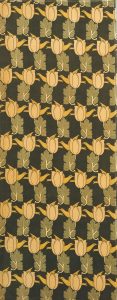
Wandle Designed by William Morris (British, Walthamstow, London 1834–1896 Hammersmith, London) Manufactured by Merton Abbey Tapestry Works (British, founded 1881) Morris & Company Registered 1884, printed 1917–23British, Merton Abbey Cotton. This printed design was achieved by a combination of indigo discharge and block printing. This process began with dying the entire cloth indigo blue, the areas that were not to remain blue were bleached (indigo discharged) and remaining colours were applied by the block printing method. The title of the design refers to the river on which the Merton Abbey textile mill was situated—that river being absolutely crucial as a source of power and clean water for textile processing.
Length of printed velveteen Charles F. A. Voysey (British, Hessle, Yorkshire 1857–1941 Winchester) Turnbull & Stockdale, For firm of Liberty & Co. (British, founded London, 1875) 1890s British, Ramsbottom, Lancashire Cotton. Voysey supplemented his small architectural practice by designing all kinds of domestic decorative items: furniture, metalware, wallpaper, carpets, and textiles. His patterns are distinctive, with stylized plants and birds, in a range of muted subtle colors.
Allegorical Figures Léon Victor Solon (1872–1957) Thomas Wardle & Co. ca. 1893 British, silk. This piece represents the only known design by Léon Victor Solon (1872 – 1957)…he worked primarily as a ceramic artist for the English firm of Minton, and was well known for his successful interpretation of Art Nouveau-style of floral and figural compositions on ceramic tiles and decorative vases. In addition to being printed on silk it was also printed on cotton velveteen, which was a common furnishing textile of the period.
Text: Melinda Watt “Nineteenth-Century Textile Production” In Heilbrunn Timeline of Art History. NY MET 2000
_____________________________
____________________________________________________

